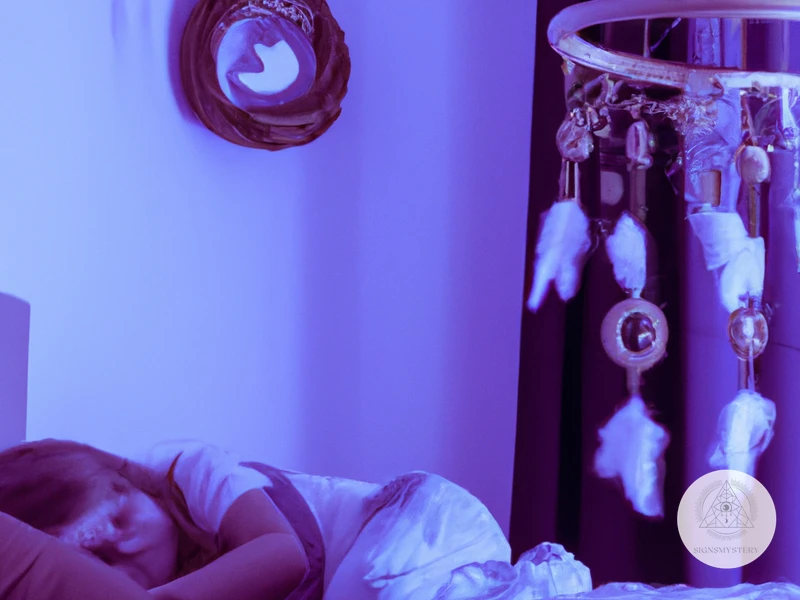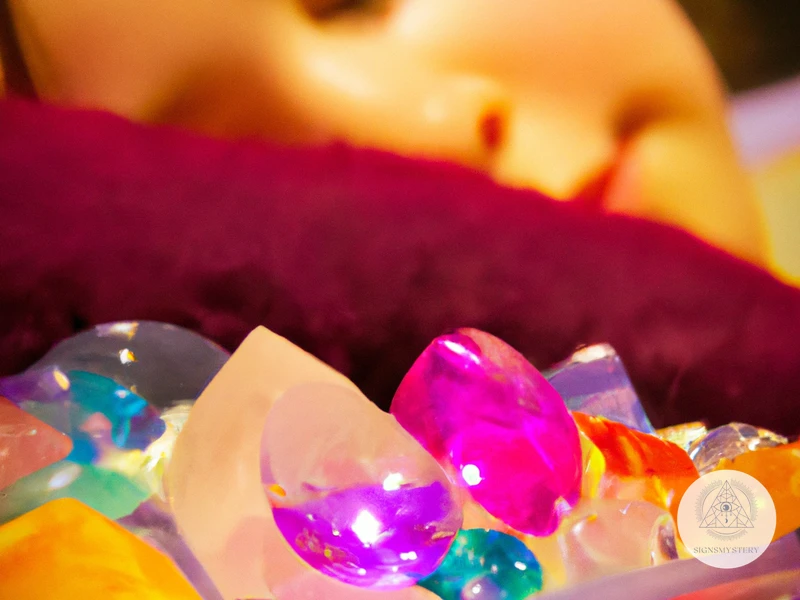Do you struggle to get your child to fall asleep at night? As a parent, it can be frustrating when your little one tosses and turns, unable to drift off into a peaceful slumber. Fortunately, there are natural remedies that can help promote better sleep for children. One such remedy is the use of crystals. Crystals have been used for centuries to promote relaxation and balance, and they can be highly effective at calming the mind and easing restlessness. In this article, we will explore the importance of sleep for children, how crystals can aid in better sleep, tips for choosing the right crystals, and various techniques for using crystals to enhance your child’s sleep environment. So, let’s dive in and discover the wonderful world of crystals for better sleep in children!
The Importance of Sleep for Children

Sleep is vital for the overall health and well-being of children. It is during sleep that their bodies and minds rejuvenate and repair from the day’s activities. Sufficient sleep fosters growth and development, boosts the immune system, and enhances cognitive function. Lack of proper sleep can lead to a range of issues, including irritability, difficulty concentrating, weakened immune system, and behavioral problems. Adequate sleep also helps regulate emotions and promotes a positive mood, which is essential for a child’s overall happiness and emotional well-being.
For children, who have boundless energy and curiosity, bedtime can sometimes be a challenge. They may resist sleeping, preferring to stay awake and continue exploring the world around them. This is where crystals can play a significant role in promoting better sleep. By using crystals in their sleep routine, children can tap into the calming and soothing energies of these natural wonders, helping them relax and prepare their minds and bodies for a restful night’s sleep.
Crystals are known for their unique properties and vibrations, which can have a profound impact on the energy in our bodies. Incorporating crystals into a child’s sleep routine can help create a peaceful and harmonious environment that supports their sleep-wake cycle. Whether it’s through the energy cleansing and grounding properties of crystals or their ability to alleviate anxiety and promote a sense of calm, these beautiful gemstones can be a valuable tool in enhancing the quality of sleep for children.
How Crystals Can Help
Crystals have unique energy properties that can aid in promoting better sleep for children. Here are a few ways in which crystals can help:
1. Calming and Relaxing: Crystals such as Amethyst and Lepidolite emit gentle vibrations that can help calm an overactive mind and relax the body. These crystals have a soothing energy that can ease feelings of restlessness and promote a sense of tranquility, making it easier for children to fall asleep.
2. Anxiety Relief: Some children may struggle with anxiety or worry that keeps them awake at night. Crystals like Blue Lace Agate and Selenite are known for their anxiety-alleviating properties. These crystals can help quiet anxious thoughts and create a sense of inner peace, allowing children to feel more at ease and sleep more soundly.
[Link to article about best crystals for alleviating anxiety]
3. Energy Cleansing: Crystals have the ability to absorb and transmute negative energies, creating a harmonious and balanced sleep environment. Regularly cleansing and energizing crystals, such as Moonstone, can ensure they are functioning at their best and providing optimal sleep support.
[Link to article about the importance of cleansing and energizing crystals regularly]
4. Balancing Chakras: Crystals like Apatite can help balance the throat chakra, which is associated with communication and self-expression. When this chakra is in harmony, children can better express their needs and emotions, leading to improved sleep quality.
[Link to article about Apatite crystals and the throat chakra]
By harnessing the natural energies of crystals, parents can create a soothing and supportive sleep environment for their children, helping them experience more restful and rejuvenating nights of sleep.
Choosing the Right Crystals

When it comes to choosing the right crystals to help promote better sleep in children, it’s important to consider their specific properties and energies. Here are five crystals that are particularly beneficial for improving sleep:
1. Amethyst: This crystal is renowned for its calming and soothing properties. It encourages a peaceful and restful sleep by helping to calm an overactive mind and reducing anxiety.
2. Moonstone: Moonstone is known for its nurturing and protective energy. It promotes relaxation, emotional balance, and helps alleviate insomnia, making it an ideal crystal for a peaceful night’s sleep.
3. Lepidolite: With its gentle and calming energy, lepidolite is often used to alleviate stress and anxiety. This crystal can help quiet the mind and promote a sense of tranquility, making it easier for children to fall asleep.
4. Selenite: Selenite is a powerful crystal for cleansing and purifying energy. It helps create a serene atmosphere, removes any stagnant or negative energy, and promotes a peaceful and undisturbed sleep.
5. Blue Lace Agate: This crystal is known for its soothing and calming properties. It helps soothe emotional tension, reduces stress and anxiety, and promotes a sense of tranquility, making it easier for children to relax and fall asleep.
When selecting crystals for sleep, it’s essential to tune in to your child’s intuition and choose the crystals that resonate with them the most. Encourage them to hold the crystals, feel their energy, and choose the ones they are naturally drawn to. Each child is unique, and finding the right crystal that aligns with their energy can have a more powerful impact on their sleep quality.
1. Amethyst
Amethyst is a popular crystal known for its calming and relaxing properties, making it an excellent choice for promoting better sleep in children. Its soothing energy can help quiet an overactive mind and ease feelings of stress or anxiety that may arise at bedtime. Amethyst is also believed to enhance spiritual awareness and promote a sense of peace and tranquility, creating the ideal environment for a restful night’s sleep. Placing an amethyst crystal under the child’s pillow or on their nightstand can help create a serene and calming atmosphere in their sleep space. Additionally, amethyst can assist in warding off nightmares and restless sleep, allowing children to wake up feeling refreshed and rejuvenated in the morning. The gentle energy of amethyst makes it a safe and beneficial crystal to introduce into your child’s sleep routine.
2. Moonstone
Moonstone is a gentle and nurturing crystal that can have a calming effect on children, making it an excellent choice for promoting better sleep. Its serene energy helps to ease anxiety and soothe racing thoughts, allowing children to relax and unwind before bedtime.
One way to incorporate moonstone into your child’s sleep routine is by placing a small tumbled stone under their pillow. The moonstone’s energy will work subtly throughout the night, creating a peaceful and restful atmosphere for a deep and uninterrupted sleep.
Another option is to create a crystal elixir using moonstone. To do this, place a moonstone in a glass or jar of water and let it sit overnight. The next morning, you can give your child a few sips of the moonstone-infused water before bed. This can help to infuse their body with the calming and sleep-enhancing energies of the moonstone.
When using moonstone, it’s important to cleanse and charge it regularly to maintain its effectiveness. You can learn more about the importance of cleansing and energizing crystals regularly here.
3. Lepidolite
Lepidolite is a crystal that is particularly beneficial for children who struggle with anxiety or have difficulty calming their minds at bedtime. This gentle stone is known for its soothing energy, making it an excellent choice for promoting relaxation and tranquility. Lepidolite contains high levels of lithium, which is commonly used in mood-stabilizing medications. When used as a sleep aid, this crystal can help children feel more at ease, reducing anxiety and promoting a sense of peace.
The soft, lilac color of Lepidolite is visually calming, and its energy works to quiet the mind, making it easier for children to let go of worries and racing thoughts. This crystal also has the ability to harmonize the mind and body, creating a sense of balance and promoting a deeper, more restful sleep. Lepidolite can be placed under the pillow or on the nightstand, allowing its gentle energy to surround the sleeping child throughout the night. It can also be used during meditation or incorporated into a bedtime routine, helping children unwind and prepare for sleep.
In addition to its calming effects, Lepidolite is believed to have a protective quality, creating a shield against negative energy and electromagnetic pollution. This can be especially beneficial for children who are sensitive to their environment or have trouble falling asleep due to external stimuli. By creating a calm and energetically protected sleep environment, Lepidolite can help children feel safe and secure as they drift off into dreamland.
When using Lepidolite or any other crystal, it’s important to remember that each child is unique, and their response to crystals may vary. It’s always best to let your child choose the crystal they are drawn to, as their intuition will guide them to the crystal that resonates with them the most. It’s important to cleanse and energize crystals regularly to maintain their optimal effectiveness. (You can learn more about the importance of cleansing and energizing crystals regularly here).
4. Selenite
Selenite is a powerful crystal that can aid in promoting better sleep for children. It has a gentle and calming energy that helps to soothe the mind and relax the body, making it easier for children to unwind and fall asleep. Selenite has a high vibration that can help clear any negative or stagnant energy in the surrounding environment, creating a peaceful and harmonious space for sleep.
One of the unique properties of selenite is its ability to cleanse and charge other crystals. Placing other crystals on top of or near a selenite crystal can help amplify their energy and enhance their sleep-promoting properties. This makes selenite an excellent crystal to incorporate into a child’s sleep routine.
There are several ways to use selenite for better sleep. One method is to place a small selenite crystal under the child’s pillow or on the bedside table. This allows the child to benefit from the soothing and calming energy of selenite throughout the night.
Another way to enjoy the benefits of selenite is by creating a selenite grid near the bed. This can be done by arranging several selenite crystals in a geometric pattern around the bed. This grid helps to create a protective and peaceful energy field that facilitates a deep and restful sleep.
In addition to its sleep-enhancing properties, selenite has a cleansing effect on the energy body, helping to remove any negative energy or blockages that may be interfering with sleep. This makes it a valuable crystal for children who may be experiencing nightmares or night terrors.
Selenite is a wonderful crystal for promoting better sleep in children. Its soothing and calming energy, paired with its ability to cleanse and charge other crystals, makes it a valuable tool for creating a peaceful and restful sleep environment.
5. Blue Lace Agate
- Blue Lace Agate is a soothing crystal that can aid in promoting restful sleep for children. Its gentle and calming energy helps to reduce stress and anxiety, allowing for a more peaceful and relaxed state of mind before bedtime.
- This crystal is known to have a nurturing and comforting energy, which can help children feel safe and secure, facilitating a sense of peace and tranquility that is conducive to sleep.
- Blue Lace Agate is also believed to promote clear communication and self-expression, which can be particularly helpful for children who may have trouble expressing their thoughts or emotions, leading to a more peaceful bedtime routine.
- This crystal can be placed under the child’s pillow or on the bedside table to create a calming atmosphere throughout the night. Its soothing vibrations can help quiet the mind and promote a deep and restorative sleep.
- In addition to its sleep-enhancing properties, Blue Lace Agate is also wonderful for promoting feelings of tranquility and inner harmony during the day, making it a versatile crystal for overall well-being.
Using Crystals for Better Sleep
Using crystals for better sleep can be a simple and effective way to promote a peaceful and restful night for your child. There are several techniques you can try, such as placing crystals under the pillow to encourage relaxation and promote deep sleep. Another option is creating a crystal grid near the bed, which combines the energy of multiple crystals to create a harmonious and soothing environment. You can also make crystal elixirs by placing crystals in water and using the infused water in a spray bottle as a mist for your child’s bedroom. Additionally, bedtime crystal meditation can be a wonderful practice to help your child relax their mind and body before sleep. By incorporating these crystal techniques into your child’s sleep routine, you can enhance their sleep quality and create a nurturing environment for rest and rejuvenation.
1. Placing Crystals Under the Pillow
Placing crystals under the pillow of a child can be a simple yet effective way to harness the soothing and calming energies of these natural wonders for a better night’s sleep. When choosing a crystal to place under the pillow, consider stones that promote relaxation and tranquility, such as Amethyst, Moonstone, or Lepidolite.
Amethyst, known as the stone of peace, can help relieve stress and anxiety, creating a serene environment for a child to sleep peacefully. Its calming energy can also assist in soothing nightmares and promoting a restful sleep.
Moonstone, with its gentle and nurturing energy, is believed to enhance intuition and promote emotional balance. Placing a Moonstone under the pillow can help ease emotional tension and create a sense of calm, allowing for more restorative sleep.
Lepidolite, known as the stone of transition, contains high levels of lithium, which is often used in calming medications. This crystal can help calm an overactive mind, reduce anxiety, and promote a sense of relaxation and deep sleep.
When placing a crystal under a child’s pillow, it is important to ensure that the crystal is securely positioned and does not cause discomfort. Some children may prefer to have the crystal directly under their pillow, while others may prefer to keep it within a pillowcase. Encourage your child to connect with the crystal’s energy before sleep, setting an intention for a peaceful and restful night’s sleep. With the crystal close by, your child may experience a more calming and rejuvenating sleep, waking up refreshed and ready for the day ahead.
2. Creating a Crystal Grid Near the Bed
Creating a crystal grid near the bed can be an effective way to enhance the sleep environment for children. A crystal grid is a pattern of crystals arranged in a specific formation to amplify their energies and intentions. To create a crystal grid for better sleep, you can follow these steps:
1. Choose the crystals: Select a combination of crystals that promote relaxation, peace, and good sleep. Some suitable options include amethyst, moonstone, lepidolite, selenite, and blue lace agate.
2. Cleanse and energize the crystals: Before creating the grid, cleanse the crystals by using a method such as running them under water or placing them in sunlight or moonlight. This helps remove any negative energies they may have absorbed. You can also energize them by holding them in your hands and visualizing their energy becoming pure and vibrant.
3. Find an appropriate location: Look for a space near the child’s bed where you can safely arrange the crystals. It can be a bedside table, shelf, or any other flat surface.
4. Set your intention: Before placing the crystals, set your intention for the grid. For example, you can intend for the crystals to promote peaceful sleep, protect against nightmares, or induce a sense of calmness.
5. Arrange the crystals: Place the crystals in a pattern that resonates with you. You can use a circular or rectangular shape, or any other design that feels right. Start by placing a larger crystal in the center as a focal point and then arrange the other crystals around it. You can also incorporate other elements such as flowers, feathers, or candles if desired.
6. Activate the grid: Once the grid is set up, activate it by using your intention and visualization. Envision the energy of the crystals merging together to create a harmonious and soothing environment.
The crystal grid can remain near the child’s bed for as long as desired. It’s important to periodically cleanse and recharge the crystals to maintain their energetic effectiveness. This technique can help create a peaceful and supportive energy field that promotes better sleep and relaxation for children.
3. Making Crystal Elixirs
Making crystal elixirs is a wonderful way to harness the healing properties of crystals and incorporate them into your child’s sleep routine. Crystal elixirs are essentially infused water that has been charged with the energy of the crystals. Here’s how you can make crystal elixirs:
- Choose a crystal that promotes relaxation and sleep, such as Amethyst or Moonstone.
- Cleanse the crystal by rinsing it under running water or using methods like smudging or sound cleansing.
- Place the cleansed crystal in a glass jar or bowl filled with filtered water. Make sure the crystal is fully submerged.
- Set the jar or bowl in a spot where it can be exposed to sunlight or moonlight for several hours. This allows the water to absorb the crystal’s energy.
- After a few hours, remove the crystal from the water.
- Your crystal elixir is now ready to use. You can have your child drink the elixir before bedtime or use it as a spray to mist their pillow or sleep area.
It’s important to note that not all crystals are safe to use in water elixirs. Some crystals may contain toxic substances or dissolve in water. It’s essential to research and ensure the crystal you choose is safe for making elixirs. Alternatively, you can place the crystal near a container of water to charge it and then transfer the energy to a separate vessel of water for consumption.
Crystal elixirs can be a gentle and effective way to incorporate the healing benefits of crystals into your child’s bedtime routine. Always supervise young children when using crystal elixirs and ensure they are made with safe crystals.
Tips for Enhancing Your Child’s Sleep Environment

- Keep the Bedroom Calm and Clutter-Free: Create a peaceful sleep environment by minimizing distractions and clutter in your child’s bedroom. Keep toys, electronic devices, and other stimulating items out of the bedroom to promote relaxation.
- Establish a Relaxing Bedtime Routine: Create a consistent bedtime routine that helps your child wind down and prepare for sleep. This can include activities like reading a book, taking a warm bath, or practicing deep breathing exercises.
- Limit Electronic Devices Before Bed: The blue light emitted by electronic devices can disrupt sleep patterns. Encourage your child to avoid screens at least an hour before bedtime to promote better sleep.
- Use Soft Lighting and Soothing Scents: Create a calming atmosphere in the bedroom with soft lighting, such as a nightlight or dimmed bedside lamp. Consider using lavender or chamomile essential oils to promote relaxation.
- Encourage Regular Sleep Schedule: Establishing a consistent sleep schedule helps regulate your child’s internal clock. Encourage them to go to bed and wake up at the same time every day, even on weekends.
By implementing these tips, you can create an environment that supports your child’s sleep and helps them get the rest they need for optimal growth and development.
1. Keep the Bedroom Calm and Clutter-Free
Creating a calm and clutter-free bedroom environment is essential for promoting better sleep in children. When a child’s bedroom is filled with clutter, it can create a sense of chaos and overstimulation, making it difficult for them to relax and unwind. Here are some tips to keep the bedroom calm and clutter-free:
- Organize and declutter: Start by clearing out any unnecessaryitems and organizing the space. Remove any toys, books, or other items that are not essential for sleep. Keep only the essentials, such as a comfortable bed, a nightlight, and any necessary sleep aids.
Subscribe to Our Newsletter
Sign up to receive the latest news and updates.
- Create a peaceful ambiance: Use soft, calming colors on the walls and choose bedding and curtains with soothing patterns. Avoid bright, stimulating colors that can be energizing or distracting.
- Minimize distractions: Remove electronic devices, such as televisions, tablets, and smartphones, from the bedroom. These devices can emit blue light, which can interfere with the production of melatonin, a hormone that regulates sleep.
- Provide ample storage: Make sure there is enough storage space in the bedroom to keep toys and other items organized. Use bins, shelves, and baskets to keep items out of sight and create a clutter-free environment.
- Encourage a clean and tidy routine: Teach your child the importance of keeping their bedroom clean and tidy. Establish a routine where they are responsible for putting away toys and other items before bedtime, promoting a sense of order and calm.
Maintaining a calm and clutter-free bedroom environment can significantly contribute to better sleep for children. A serene and organized space will help create a sense of peace and relaxation, allowing your child to drift off into a restful sleep with ease.
2. Establish a Relaxing Bedtime Routine
Establishing a relaxing bedtime routine is crucial for helping children wind down and prepare for a restful sleep. A consistent routine signals to the body that it is time to relax and unwind, promoting a sense of calmness. Here are a few tips to help you establish a relaxing bedtime routine for your child:
- Create a calming environment: Set the stage for relaxation by creating a soothing environment in your child’s bedroom. Use soft lighting, such as a dim bedside lamp, to create a peaceful ambiance. Consider incorporating soothing scents, like lavender essential oil, which is known for its calming properties.
- Engage in quiet activities: Encourage your child to engage in quiet and relaxing activities before bed. This can include reading a book together, listening to soothing music, or practicing deep breathing exercises. Avoid stimulating activities or screen time, as they can interfere with the ability to unwind.
- Establish a consistent bedtime: Consistency is key when it comes to a bedtime routine. Set a specific time for your child to go to bed each night, ensuring they get enough sleep for their age. This helps regulate their internal body clock and promotes a more natural sleep-wake cycle.
- Encourage relaxation techniques: Teach your child simple relaxation techniques that can help them calm their mind and body. This can include gentle stretching exercises, progressive muscle relaxation, or guided imagery. By practicing these techniques together, your child can learn how to relax their body and mind before sleep.
- Provide comfort items: Consider allowing your child to have a comfort item, such as a special stuffed animal or blanket, that provides them with a sense of security and comfort. This can help them feel safe and relaxed as they drift off to sleep.
By establishing a bedtime routine that promotes relaxation, you can help your child transition from the busyness of the day to a peaceful and restful sleep. A consistent routine can also help signal to their brain and body that it’s time to sleep, making it easier for them to fall asleep and stay asleep throughout the night.
3. Limit Electronic Devices Before Bed
- Avoid screen time: Limiting the use of electronic devices before bed is crucial for promoting better sleep in children. The blue light emitted by screens, such as smartphones, tablets, and televisions, can interfere with the production of melatonin, the hormone that regulates sleep. Encourage your child to engage in calming activities, such as reading a book or listening to soft music, instead of being glued to screens.
- Establish a digital curfew: Set a specific time at which all electronic devices are turned off and put away for the night. This will help signal to your child’s brain that it’s time to wind down and prepare for sleep. Creating a consistent bedtime routine that includes a designated “digital curfew” can help regulate their sleep-wake cycle and promote healthier sleep habits.
- Create a device-free bedroom: Make your child’s bedroom a technology-free zone. Remove any devices from their sleeping environment, including televisions, computers, and gaming consoles. This helps create a calm and distraction-free space that is conducive to quality sleep.
- Encourage alternative activities: Replace the use of electronic devices with relaxing and calming activities before bed. Encourage your child to engage in activities such as coloring, journaling, gentle stretching, or practicing deep breathing exercises. These activities can help calm their minds and prepare their bodies for a more restful night’s sleep.
4. Use Soft Lighting and Soothing Scents
Creating a relaxing sleep environment for your child involves not only using crystals but also considering the lighting and scent in their bedroom. Soft, dim lighting can help create a calming atmosphere that signals to the brain that it’s time to wind down and prepare for sleep. Avoid bright overhead lights in the evening and opt for soft bedside lamps or nightlights instead. This gentle illumination will help promote a sense of relaxation and serenity in the room.
In addition to lighting, soothing scents can also contribute to a tranquil sleep environment. Certain essential oils, such as lavender and chamomile, have calming properties that can help induce a sense of calmness and aid in the sleep process. You can use an essential oil diffuser or a spray bottle diluted with water to infuse the air with these scents. Alternatively, you can place a few drops of essential oil on a cotton pad and tuck it under your child’s pillow. The gentle aroma will create a soothing ambience, promoting a peaceful and restful sleep.
Tip: Make sure to use child-safe essential oils and always follow the recommended dilution ratios to ensure the safety of your child. It’s important to note that babies under six months old should not be exposed to essential oils.
5. Encourage Regular Sleep Schedule
Establishing a regular sleep schedule is crucial for children to get the adequate amount of sleep they need. Consistency is key when it comes to sleep routines, as it helps regulate their internal body clock and promotes healthier sleep patterns.
To encourage a regular sleep schedule for your child, consider the following tips:
- Set a consistent bedtime: Determine a specific time for your child to go to bed each night. This helps their body anticipate and prepare for sleep.
- Create a bedtime routine: Develop a calming routine leading up to bedtime. This could include activities like reading a story, taking a warm bath, or practicing relaxation techniques.
- Avoid stimulating activities: Limit activities that can energize or excite your child close to bedtime. This includes avoiding stimulating electronic devices like tablets or video games.
- Limit napping: If your child still takes daytime naps, ensure that they are not too close to bedtime. Napping too late in the day can interfere with their ability to fall asleep at night.
- Wake up at the same time: Encourage your child to wake up at the same time every morning, even on weekends. This helps reinforce their internal body clock and promotes a consistent sleep-wake schedule.
By following a regular sleep schedule, your child’s body will naturally adjust and anticipate sleep at the designated bedtime. This will make it easier for them to fall asleep and establish healthier sleep habits, leading to better overall sleep quality.
Conclusion
In conclusion, incorporating crystals into your child’s sleep routine can be a natural and effective way to promote better sleep. The importance of sleep for children cannot be overstated. It is during sleep that their bodies grow, their minds recharge, and their emotional well-being is nurtured. Crystals offer unique properties that can help create a calming and soothing environment, making it easier for children to relax and fall asleep. Whether you choose to place crystals under their pillow, create a crystal grid near their bed, make crystal elixirs, or engage in bedtime crystal meditations, there are various techniques you can try to enhance the power of crystals and support your child’s sleep. Additionally, establishing a calm and clutter-free bedroom, incorporating a relaxing bedtime routine, limiting electronic devices before bed, using soft lighting and soothing scents, and encouraging a regular sleep schedule can all contribute to a positive sleep environment for your child. So, why not give crystals a try? Your child may just find that their dreams are sweeter and their sleep is more restful with these magical gems by their side.
Frequently Asked Questions

1. Can crystals really improve sleep for children?
Yes, crystals can help improve sleep for children by promoting relaxation and a sense of calm. Their unique energies can assist in easing restlessness and quieting the mind, making it easier for children to fall asleep and stay asleep.
2. Are there specific crystals that are more effective for better sleep?
Yes, certain crystals are known for their sleep-enhancing properties. Amethyst, moonstone, lepidolite, selenite, and blue lace agate are some of the crystals that are particularly effective in promoting better sleep for children.
3. How can I use crystals to improve my child’s sleep?
There are several ways to use crystals for better sleep. You can place them under your child’s pillow, create a crystal grid near their bed, make crystal elixirs, or incorporate them into bedtime meditation. These methods harness the energy of crystals to create a calming sleep environment.
4. Are there any safety considerations when using crystals with children?
While crystals are generally safe to use with children, it’s important to choose crystals that are non-toxic and child-friendly. Additionally, always supervise children when using crystals to ensure they don’t put them in their mouths or misuse them.
5. How long does it take for crystals to start having an effect on sleep?
The effects of crystals can vary from person to person. Some children may experience immediate benefits, while for others, it may take a few days or weeks to notice a difference. It’s best to be consistent with crystal use and observe your child’s sleep patterns over time.
6. Can crystals replace other methods to promote better sleep for children?
Crystals can be a helpful addition to other methods for promoting better sleep, but they may not replace healthy sleep habits and routines. It’s important to establish a relaxing bedtime routine, create a calm sleep environment, and practice good sleep hygiene alongside crystal use.
7. Can I use more than one crystal at a time for better sleep?
Absolutely! You can combine multiple crystals to amplify their sleep-enhancing energies. Experiment with different combinations and trust your intuition to find the crystals that work best for your child’s sleep needs.
8. Are there any specific crystals that can help with nightmares or night terrors?
Yes, certain crystals like amethyst, labradorite, and smoky quartz are believed to help alleviate nightmares and night terrors. Placing these crystals under the pillow or near the bed can create a soothing and protective energy that can aid in peaceful sleep.
9. Can I use crystals for better sleep in babies and toddlers?
Absolutely, crystals can be used for better sleep in babies and toddlers as well. However, always ensure that the crystals are secure and do not pose a choking hazard. It’s also important to monitor their sleep environment and create a safe space for crystal use.
10. Can adults also benefit from using crystals for better sleep?
Yes, adults can certainly benefit from using crystals for better sleep. The calming and balancing energies of crystals can help relax the mind and body, promoting a deeper and more restful sleep experience.
References
Frequently Asked Questions

1. Can crystals really help children sleep better?
While there is no scientific evidence to support the effectiveness of crystals for sleep improvement, many people believe in their healing properties and use them as complementary tools for better sleep.
2. Are there any specific crystals that work best for children’s sleep?
Some popular crystals believed to promote better sleep in children include Amethyst, Moonstone, Lepidolite, Selenite, and Blue Lace Agate. Each crystal is said to have its unique properties that aid in relaxation and calming the mind.
3. How should I choose the right crystal for my child?
The best way to choose a crystal for your child is to go with your intuition and let them pick one that resonates with them. You can also consider their birthstone or seek guidance from a crystal healer or expert.
4. Can I place crystals under my child’s pillow?
Yes, you can place crystals under your child’s pillow to promote better sleep. However, it’s important to ensure that the crystals are small enough and do not pose a choking hazard. You can also consider placing them nearby on a bedside table.
5. How do I create a crystal grid for better sleep?
To create a crystal grid, you can select multiple crystals and arrange them in a specific pattern near your child’s bed. This arrangement is believed to amplify the energy of the crystals and promote better sleep.
6. Are crystal elixirs safe for children?
Crystal elixirs involve infusing water with the energy of crystals. It is generally recommended to avoid giving crystal elixirs to young children due to the risk of ingesting small crystal fragments. It’s best to consult with a crystal expert or healer before using crystal elixirs for children.
7. How can bedtime crystal meditation help my child sleep better?
Bedtime crystal meditation involves using crystals during a guided meditation or visualization practice before sleep. It can help calm the mind, release stress, and create a peaceful and relaxed state, which can ultimately lead to better sleep for your child.
8. What are some tips for creating a calm sleep environment for my child?
To create a calm sleep environment, keep the bedroom clutter-free, use soft lighting, and incorporate soothing scents like lavender. Establishing a relaxing bedtime routine and limiting electronic devices before bed can also contribute to a peaceful sleep environment.
9. Is it important to maintain a regular sleep schedule for children?
Yes, maintaining a regular sleep schedule is crucial for children. Consistent bedtimes and wake-up times help regulate their internal body clock, improve sleep quality, and ensure they get the recommended amount of sleep for their age.
10. Can crystals replace traditional sleep interventions for children?
No, crystals should not replace traditional sleep interventions for children. They can be used alongside other strategies such as maintaining a healthy sleep routine, creating a conducive sleep environment, and addressing any underlying sleep issues through medical or professional guidance.
References
- 7 healing crystals for children
- Best Crystals for Sleep and Insomnia
- Crystals for Sleep: Catch More ZZZ’s with These Healing …










